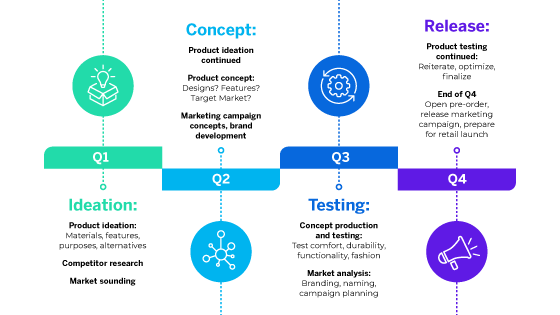Every year, over 30,000 new products are introduced to the market — but around 95% of them fail.
As markets become saturated with similar products and services, it’s increasingly difficult for new offerings to make an impact. Most fall at the first hurdle due to not having a solid product launch plan, while others fail to position themselves well enough for prospective customers.
For product managers, then, the question is: how do you create compelling products that offer value to your customers and ensure you stand out in a highly competitive market?
Your product might tick all the right boxes, but do you have a robust and comprehensive product strategy to make the right impact from the start?
In this guide, you’ll find out what types of product launches there are, what product launch strategy is, and how you can use our template and checklist to get your product ready to go.
What is a product launch?
A product launch is a coordinated effort to bring a new solution to the market. The goal? To build excitement for and awareness of your product.
Product launches involve several teams, including the sales team, the customer support team, product teams, product marketing, event management, and even managers. Each team aligns and works together to maximise launch potential — building anticipation, interest, brand awareness, and momentum in the process.
Some product launches are more memorable and successful than others. When Apple releases a new iPhone, for example, they distribute several press releases and stories before unveiling the new design at their annual conference. This creates so much excitement and hype that would-be users queue overnight at retail stores to get the device.
A successful product launch not only leads to greater interest and sustained sales-generated revenue, but it can also boost your other products if they’re bundled into launch packages.
A failed product launch can result in more than lost sales opportunities: it can create a bad impression of your brand as a whole and provide little to no return on your investment.
When should you think about a product launch?
Before getting to the product launch stage, most product development teams go through a few stages: ideation, product concepts, and testing. They then work with marketing teams and sales teams to come up with a product launch strategy for release.

This includes:
Identifying unmet needs
- Audience research: Who do you want to reach and target? With things like demographic segmentation, it becomes easier to hone your approach.
- Audience breakdown: Find out who your audience is and deliver personalised messages and campaigns using market segmentation.
- The buyer journey: How do your prospects engage with your business and signal they are ready to buy?
- Market landscape assessment: Assess the entire landscape of your product, brand, and category offerings to identify any whitespace growth opportunities. Learn about consumer preferences, motivators, and barriers to purchase — all before designing anything new for them.
Ideation and brainstorming
- Concept creation: Come up with product concepts and ideas to address the issues you’ve identified.
- Goal setting and problem-solving: As you develop the concept, define your problem and see how the product benefits and features can help your customers resolve the issue.
- Idea screening: Screen your ideas to discover which resonate most with your respondents. This helps you target early-stage innovation efforts to focus on the product lines with the most potential. Check out our idea screening here.
Concept testing
- Concept testing: Use product validation methods early to see if your product concept meets the needs and wants of your customers.
Own your testing with our Product Concept Testing Tool. Check it out here.
Product testing, preview programs, and early access
- Product testing: Gather views on the beta product using market research, then refine it based on what customers want to see. You can also try out our free product research template to evaluate your consumers’ reaction to a new product across every stage of the product team development journey.
- Preview programs or early access: Early access programs provide a way for select users (new or existing) and partners to preview product builds for testing purposes and participate in the development process. Using their feedback, you can drastically improve your offering and create a more market-ready solution.
Launch readiness
- Conjoint dynamics images (packaging): Test packaging designs to find out what would resonate with users. Find out more about conjoint analysis here.
- Product pricing research: Discover what customers would be willing to pay for your product or service and by doing so, uncover the optimal price point to maximise profit, revenue and/or market share.
- Product marketing: How can you make your product’s story shine and build awareness of the product? Have you thought about key features and key messaging that needs to be included in your marketing campaigns? Read more about this in our product marketing 101 guide.
- Communication channels: Understand how you can connect with your target audience, and see which communications channels (including email, social media, and telephone) would be most effective.
- Execution checklist: What needs to be prepared before the launch date? Does your sales team have all the materials they need to encourage purchases and answer questions? Is your customer support department on hand and ready to assist? What about your marketing team? What content assets are they going to share or promote during and after the launch? We’ve put together a checklist you can use. Just click here.
eBook: 12 business decisions you can optimise with conjoint analysis
Now let’s look at what’s included in a project launch plan and then move on to the three types of product launch.
What is included in a product launch?
There are five key parts to a product launch plan:
- A clear vision: As the product launch can’t happen without the help of your internal departments’ support, make sure everyone is aware of the goal and understand the aim of and need for the product.
- A strategy: How will you bring the product to market? A strategy defines how you’ll go from A to B. This is a customer-focused plan with tasks and timelines built around delivering value to the end-user. It’ll help keep your teams focused and moving in the same direction.
- A communication plan: Regular catch-ups, team meetings, scrums, stand-ups, stakeholder and board meetings — they all help to keep everyone aware of the current state of play and how the product launch plan is progressing. Keep them quick and efficient for maximum value. But as well as communicating with your teams, have a plan for engaging with your prospects and customers.
- A product launch checklist: A list of final pre-launch activities to ensure the product launch is a success.
- A system to measure success: To understand how your product is performing, and subsequently improve it, you need a system to measure your success. Through it, you can monitor revenue, adoption, engagement, and satisfaction, and look at customer and market feedback to enhance your offering.
What are the three types of product launch events?
You can choose from three types of launch events, each having its benefits:
- Minimal viable product (MVP): A barebones solution with just the core features and functionality that’s designed to give you a ‘flavour’ of the product. MVPs help bring the product to life and support product testing with target audience members. From these tests, you can see if your product is hitting the mark with target customers and make changes based on their feedback.
We’ve got a better option
At Qualtrics, we opt for a Minimum loveable product (MLP). More than just viable, an MLP product is something that can delight customers as well as solve their pain points and challenges. It’s built with the customer and functionality in mind, whereas an MVP product might not necessarily delight or satisfy — affecting brand perception, loyalty, and the possibility of business in the future.
- Soft: A soft launch or a beta launch, is when the product is released under special circumstances that limit who can preview the product. This can help you make last-minute changes or build up momentum in advance with reviews. For example, there can be previews of new films, or a limited release to specific target audiences and journalists to get feedback and responses.
- Full-scale: A full-scale launch, also known as a hard launch or an official release, is when the product is fully available to the general public to purchase. It’s an ‘all or nothing’ launch event that aims to make a big impact and get sales moving fast. Most products go straight to full-scale launch when they are ready to go to market.
Defining your product launch strategy
To ensure the success of your product launch, you need a document that outlines key objectives, activities, goals, performance indicators, teams, and responsibilities (this includes everything mentioned thus far).
By having a clear product launch plan, you ensure that your teams are on the same page, aligned, and ready to do their part. You should also consider documenting post-launch activities, such as customer support, training (where necessary), and continuous improvement of the product.
To help you, we’ve put together a brief template below. By filling in this launch template, you can formulate the skeleton of your plan.
Product launch template
To get you started, here’s our easy product launch template for your product launch planning. Just fill in the sections below in as much detail as you can.
The product:
- A description of the product
- What challenges it solves for the customer
- What the features and benefits are
- The target price range for the product
- The financial investment to date
- The team members involved in the product launch and what they are responsible for
The customer:
- A description of the target customer and relevant market segments (include customer personas if you have them) and use cases — e.g. areas where the product can help or the jobs it can do.
The goals:
- What are the key goals for the product? (e.g. revenue, market presence, adoption, etc.)
- How will you monitor and measure your goals?
The launch event:
- The budget for the activities
- The vision and description of the product launch (what will you cover, speakers, presenters, etc.)
The timeline and milestones of the product launch:
- List the activities with the deadlines for completion and create
- This should include the most pertinent elements to ensure a successful launch
- When you will bring internal teams together to discuss the progress and updates
- Routine meetings and updates will keep teams aligned
The product marketing and communications plan:
- What are the core messages that you want customers to know?
- What channels will you use?
- What marketing collateral do you need to create? (e.g. brochures, press releases)
After filling out the document, create a concise summary to share with executives. This will provide them with a high-level overview of your project and the main elements, such as key messages, goals, metrics to monitor, and requirements for the product launch. This document is also useful for those who want to get up-to-speed with a project quickly and don’t necessarily need to know the details of each operation.
Examples of successful product launches in different industries
Under Armour (performance sports clothing brand)

To support the launch of the HOVR Infinite shoe, Under Armour wanted to scale its product testing to get actionable insights, faster. The problem was that Under Armour only had 100 product testers and they didn’t have enough representation across the countries it operated in.
With a centralised directory on the Qualtrics platform, Under Armour quickly went from about 100 product testers to over 10,000 and had greater representation across the globe. This helped shorten the feedback loop, enabling Under Armour to conduct more rounds of testing than ever before and refine the HOVR cushioning platform quickly.
The testing helped make a product that professional runners were praising in glowing terms. Within weeks of its product launch to the public, the HOVR Infinite received a 2019 Runner’s World Recommendation Award.
Yamaha

When you want your products to be as innovative as the artists who use them, you need an insight platform that’s fast and flexible enough to put the customer’s voice into every step of your product launch process.
Using Qualtrics, Yamaha runs hundreds of quick-turn studies during product development to ensure they catch potential product misfires before prototypes hit the development floor — or the finished product goes to market.
They use Qualtrics’ survey capabilities to survey customers, receiving rich, detailed feedback and insight in a matter of hours — something that might’ve taken a week or more to deploy and discuss internally.
Now, they’re able to conduct projects and continue producing amazing products with incredibly fast turnaround times.
Want to see some more examples?
Read how working with Qualtrics helped:
- Technology brand Pinterest to identify the precise motivations behind its creators. They found their users needed not just posting tools, but innovative tools. This led to the product launch of an entirely new feature set.
- Food producer Chobani to tailor its marketing and advertising programs for maximum impact for its ‘Flip’ products range
- Entertainment provider Fandango to increase customers booking tickets further out and more often.
Finally, your launch checklist — a great way to ensure you’ve ticked all the boxes.
Product launch checklist
Have those examples got your creative juices flowing? We hope so! Before the big day, cover your bases by using this product launch checklist:
- Have all team members completed their activities to the milestones and deadlines provided?
- Has the product been tested with target customers in a controlled setting and the feedback recorded and actioned?
- Has the product team completed the development roadmap and is it ready for release?
- Has a product launch event type been chosen?
- Have internal teams been trained on the new product?
- Has the marketing collateral been distributed in advance?
- Is the entire organisation informed about the product launch date?
- Have you mapped the customer journey touch-points and ensured that the customer will get a good user experience throughout the interaction?
- Have you set up a system to track the right metrics that will help you with understanding the product performance?
- Have you set aside people resources to carry out the analysis of product metrics results for actionable intelligence?
- Have you had a final meeting to go through the product launch event itinerary and timelines?
- Have you set up communication loops that help you feed information to the right departments and people?
- Have you arranged the reporting templates that will lay out information in the right way for easy understanding?
How can Qualtrics help?
Having the right system in place can mean the difference between a successful product launch or a failure. With an all-in-one system of action for product concept testing, market research, panel management, segmentation, and more — your product management team has everything they need to ideate, test, create, improve and deliver successful products.
Here are just a few things you can do using Qualtrics’ solutions:
- Gather and analyse customer data and insights
- Track the different stages of the product development
- Carry out and record the results from product testing
- Set up analytics to monitor, collect and analyse performance results
- Access easy-to-use dashboards for at-a-glance insights
- Automatically update and alert relevant stakeholders with tailored reports
And you can go a step further using Qualtrics Design XM™ — our solution that offers:
- MARKET SEGMENTATION – Track consumer behaviour across unique segments, and take specific actions based on the value associated with each customer type.
- PRODUCT DEVELOPMENT & PRICING – Gather customer feedback on new products and services early and throughout the development cycle to save time and money.
- PANEL MANAGEMENT – Turn email lists, site visitors, members of your social media groups, and others into your research panels. A ready and willing panel increases response rates and turnaround times for any research you’re conducting.
It’s not just about creating great products. It’s about creating great experiences to go with them.
If you want to find out more about how Qualtrics Design XM™ can benefit your product team, pre-launch, during, and post-launch, why not sign up for a free, personalised demo? Just click on the link below!
Improve your product launch with Qualtrics DesignXM